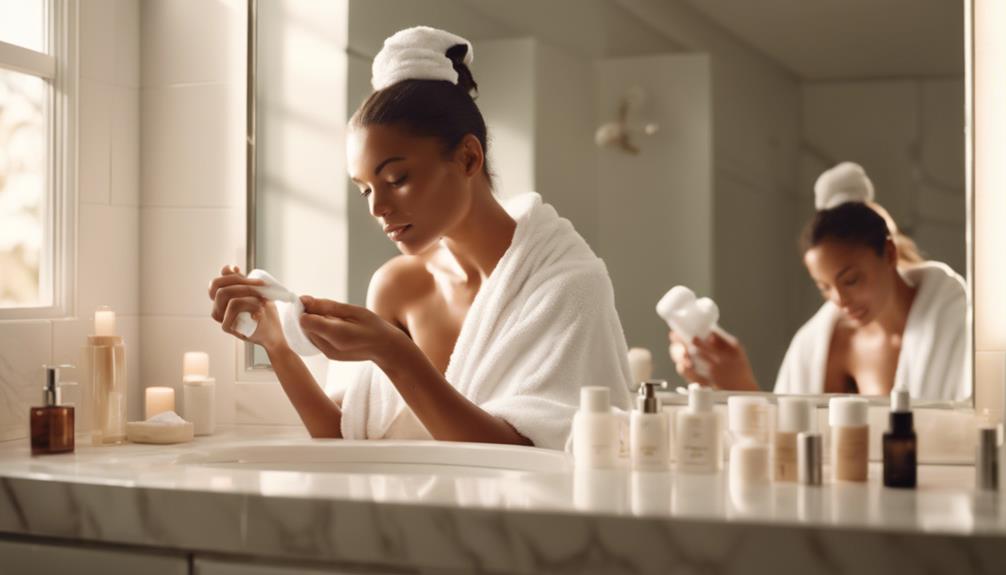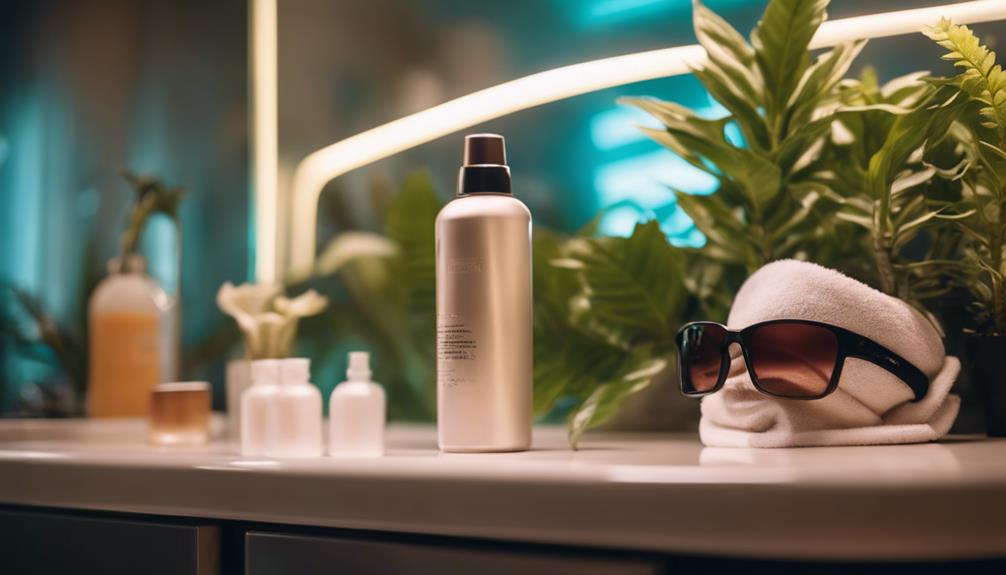To achieve a glowing complexion after tanning, it is important to moisturize effectively. Hydrating the skin is crucial in order to maintain the vibrancy of your tan and prevent dryness and patchiness. Select a moisturizer that suits your skin type, preferably containing nourishing ingredients such as aloe vera or shea butter, and add antioxidants for skin repair. The timing of when you moisturize is important; apply a water-based moisturizer right after tanning and establish a nightly skincare routine. Pay close attention to areas that are prone to dryness like elbows and knees, and consider layering products for added hydration. In addition, keep your skin healthy by staying hydrated and gently exfoliating. For more tips on how to perfect your post-tan skincare routine, continue exploring different options.
Key Takeaways
- Apply a water-based moisturizer immediately after tanning to lock in moisture and enhance tan longevity.
- Choose products with hydrating ingredients like aloe vera or shea butter tailored to your skin type.
- Focus on key moisture-prone areas like elbows and knees, and exfoliate regularly for an even tan.
- Establish a nightly moisturizing routine to support skin recovery and maintain a radiant glow.
Importance of Hydration
Hydration is essential for preserving the vibrancy of a tan while ensuring the skin remains smooth and free from dryness or flakiness.
Post-tanning, maintaining adequate moisture levels in the skin is vital to prevent undesirable effects such as patchiness and uneven fading.
Regularly moisturizing acts as a barrier that locks in hydration, promoting a consistent and healthy appearance.
This routine not only enhances the longevity of the tan but also contributes to an overall improvement in skin texture.
Proper hydration helps to mitigate the effects of sun exposure, reducing the risk of irritation and damage.
Ultimately, prioritizing hydration is key to achieving a radiant, well-maintained complexion after tanning.
Choosing the Right Moisturizer
Selecting the appropriate moisturizer is essential for enhancing skin hydration and ensuring the longevity of your tan.
When choosing a moisturizer, consider your skin type. For oily skin, opt for non-comedogenic formulas that won't clog pores. If you have dry skin, look for products containing hydrating ingredients like aloe vera or shea butter to restore moisture.
Additionally, incorporating body creams rich in antioxidants can aid in repairing skin post-sun exposure. Lightweight products are preferable, as they provide a smooth application without feeling heavy.
For an extra hydration boost, consider adding oils such as jojoba or coconut oil.
Timing and Routine

Establishing an effective moisturizing routine is essential for maximizing tan retention and ensuring ideal skin hydration following tanning sessions. Begin by applying a water-based moisturizer immediately after tanning to lock in moisture. For best absorption, wait 6-8 hours before showering and pat skin dry to avoid patchiness. Consistency is key; establish a nightly moisturizing habit for prolonged hydration and glow.
| Time After Tanning | Action | Purpose |
|---|---|---|
| Immediately | Apply moisturizer | Lock in moisture |
| 6-8 hours | Wait before showering | Enhance absorption |
| Post-shower | Pat skin dry | Prevent patchiness |
| Nightly | Moisturize | Maintain hydration |
Addressing Moisture-Prone Areas
After ensuring a consistent moisturizing routine, it is important to focus on moisture-prone areas that may require extra attention to maintain an even and healthy appearance of the tan. These areas are often more susceptible to dryness, which can lead to an uneven fade.
To effectively address moisture-prone areas, consider the following:
- Target Key Areas: Apply rich moisturizers specifically to elbows, knees, and ankles, as they tend to absorb moisture less efficiently.
- Exfoliate Regularly: Prior to moisturizing, gently exfoliate these regions to improve skin texture and promote an even tan.
- Use Layering Techniques: Combine a lightweight moisturizer with a heavier cream or oil to lock in hydration for prolonged periods.
Additional Considerations

Considering various factors can enhance the effectiveness of post-tan care and guarantee a longer-lasting, radiant glow.
To begin with, clothing choices play a significant role; opt for loose, breathable fabrics to prevent rubbing and streaking of the tan.
Additionally, nighttime moisturizing is crucial for skin recovery and maintaining vibrancy. Incorporate products containing soothing ingredients like aloe vera or vitamin E, as they nurture skin while prolonging tan longevity.
Moreover, hydration is essential; drink plenty of water to support skin's health from within.
Finally, gentle exfoliation can aid in achieving an even fade, but avoid harsh scrubs that may compromise your tan.
Can After-Tan Lotion Really Help Achieve Radiant Skin Post-Tanning?
Using aftertan lotion for radiant skin can definitely help achieve a glowing complexion post-tanning. These lotions are specifically designed to hydrate and nourish the skin after sun exposure, helping to maintain a healthy, radiant appearance. Look for lotions with ingredients like aloe vera and vitamin E for the best results.
Conclusion
To summarize, the pursuit of radiant skin post-tanning necessitates diligent moisturizing practices.
Visualize a sun-kissed complexion, free from dryness and uneven patches, achieved through the careful selection of hydrating products and a consistent application routine.
By focusing on high-moisture areas and incorporating soothing ingredients, the vibrancy of a tan can be preserved, ensuring skin remains smooth and luminous.
Emphasizing these strategies will enhance not only the appearance but also the overall health of the skin.









